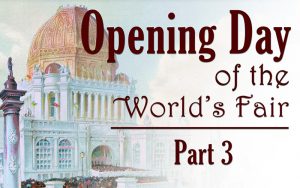
A Sea of Humanity
This is Part 3 of our series “Opening Day of the World’s Fair,” which explores the events of May 1, 1893, at the World’s Columbian Exposition in Chicago. The full series can be found here.
As the procession of the President of the United States began its march south on Michigan Avenue, thousands of people in downtown Chicago began forming their own spontaneous parade to the World’s Fair.
Everyone on West Madison Street and North Clark Street were going in one direction. When this great tempest reached the center of the city, it divided into three parts. One part dashed across the viaduct over the Illinois Central tracks, another crowded into the elevated station on Congress Street, and the crush extended for a block north, while the cable cars were so jammed inside and out that they had the appearance of a long row of huge black balls.
A struggling mass intent on getting to the Fair
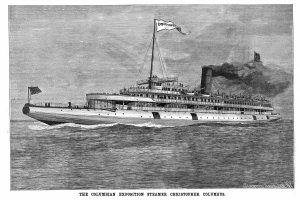
“The Columbian Exposition Steamer Christopher Columbus” [Image from Scientific American, May 13, 1893.]
Despite the disagreeable weather, thousands chose to reach the fairgrounds by carriage. The great Michigan Avenue was thronged with private carriages and conveyances. Pressed into use were all sorts of vehicles, from the lordly tally-ho with its freight of social lions down to the express wagon fitted up for the family for the occasion. Several enterprising persons put out conveyances which for style and comfort vied with those of private individuals. The Columbian Coaching Club started its well-equipped vehicles and had full loads inside and out; some distinguished citizens availed themselves of these services.
Several steamship companies ran lines between downtown and the harbor at Jackson Park. Nine big steamers loaded down with thousands of passengers plied between the Van Buren Street pier and the fairgrounds.
First visitor on the grounds
A tall, lean man from Oskaloosa, Iowa, reportedly was the first visitor on the fairgrounds on Monday morning. He chartered a rolling chair to take him to a spot directly in front of the grandstand where the Opening Ceremony would be held. Wrapping himself in a blanket, he settled back in his chair to wait for the ceremony to begin. His pockets bulged with sandwiches and refreshments of a more substantial nature.
Striking a match to light his cigar, the Oskaloosan was stopped by two Columbian Guards who informed him that no smoking was allowed on the fairgrounds. Later on Opening Day, the President of the United States would be reprimanded by another Columbian Guard for the same transgression.
Rivulets of human stream into the fairgrounds
They arrived in Jackson Park by carriage (broughams, mail phaetons, victorias, and carts of all kinds), cable car, passenger train, locomotive “cattle car,” boat, bicycle, and on foot. Every guest another drop in a gathering sea. By 9 o’clock, rivulets of humanity trickled into the court. By 10 o’clock the rivulets had grown into dark, thick streams. Before 11 o’clock fully 100,000 people were massed on the fairgrounds.
Visitors poured out of the yellow express trains of the Illinois Central and swept through the gates at Sixtieth Street. Stony Island Avenue was gorged by another stream of passengers emptying from the elevated trains.
On the east end of the park, thousands more spilled onto the granite-paved shore from lake steamers grinding against the long piers. Little launches rocked idly on the Lagoon. Occasionally a gondolier, throwing his weight against a blade, would shoot a gorgeous craft across the water.
The crowds surged about the ticket booths, burst through the turnstiles, and struck across Jackson Park from all directions. Flows converged in front of the grandstand, where the swelling sea of humanity endured a drizzle of rain.
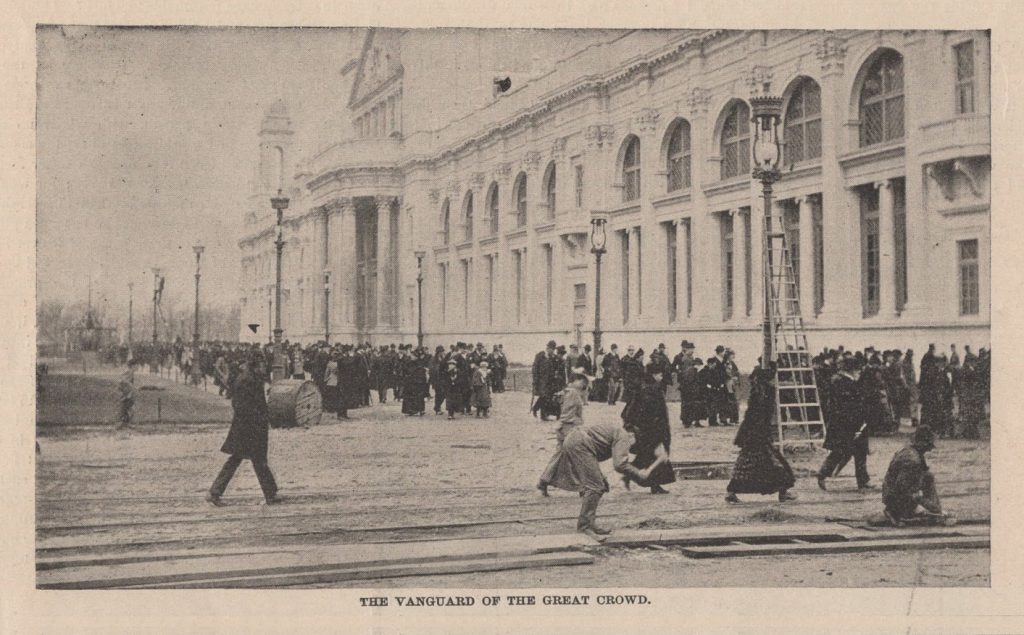
“The Vanguard of the Great Crowd” from Frank Leslie’s Illustrated Weekly, May 18, 1893.
The grandstand
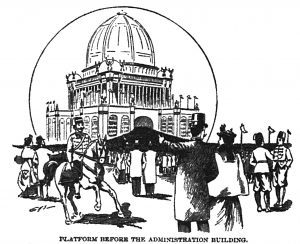
“Platform Before the Administration Building” from the Chicago Inter Ocean, May 2, 1893.
The formal opening ceremony would take place on a platform erected on the east entrance of Richard Morris Hunt’s imposing and majestic Administration Building. There, hundreds of thousands of visitors could witness the proceedings—even if they couldn’t hear much of the speeches.
This location was selected after a long and contentious battle between two factions of the local fair directors, one of which desired to have the ceremonies held in the small hall in the presence of about 2,000 invited guests. The Board of Control suddenly concluded, however, that it had something to say concerning the opening program, and President Palmer, Director-General Davis, and Secretary Dickinson, by a few strokes of the pen, upset the plans of the Exposition Committee on Ceremonies.
A sea of mud
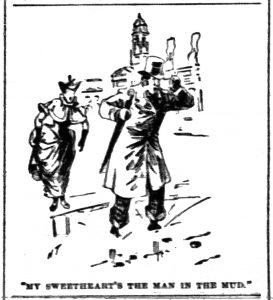
“My Sweetheart’s the Man in the Mud” from the Chicago Herald, May 2, 1893.
Morning sunshine occasionally shimmered off the roof of the Administration Building as thousands began to assemble facing the golden dome. Standing in the opposite end of the Grand Basin, the gigantic Statue of the Republic stood covered by a veil of cloth, waiting to be revealed in her golden glory.
The White City was a theater worthy of a fête of the gods—something to be imagined by a dreaming poet or read of in the pages of oriental legend. The eye could rest upon nothing that was not beautiful, barring always the sea of mud through which the unfortunate citizen was forced to wade. Mud was everywhere, and it was the softest, the dirtiest, and the muddiest kind of mud. Every man who put his foot down splashed his neighbor.
At 10 o’clock, the sixty-member Iowa State Band, sporting colorful uniforms, plodded their way through the muck on their way to the north end of the fairgrounds, where the Iowa State Building would be dedicated later in the day.
A great pansy bed blooming in the spring
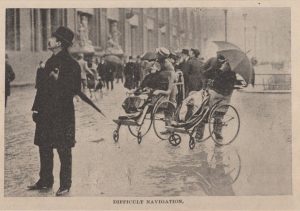
“Difficult Navigation” shows visitors looking at the Golden Door of the Transportation Building, from Frank Leslie’s Illustrated Weekly, May 18, 1893.
Out of the dirty ground grew a crowd full of color, life, and enthusiasm.
Women dressed in the gorgeous colors then in vogue mingled among men on all sides. When viewed from above, the richness of the attire of one set against the dark sobriety of the other resembled a great pansy bed blooming in the spring before its foliage becomes so dense as to hide the black earth beneath. The hats and upturned faces, varied here and there by the bright bonnets of the women, looked like the constantly changing facets of a kaleidoscope.
Rolling chairs pushed by students in blue uniforms carefully edged their way through the crowds.
Measuring humanity by the acre
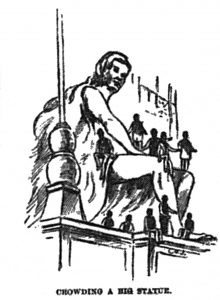
“Crowding a Big Statue” from the Chicago Inter Ocean, May 2, 1893.
Restraint is a hard harness on the American people. When arriving on the fairgrounds, they were at first restless and uneasy. Surrounded by beautiful and admirable buildings, the visitors wanted to get inside them. Soon the white palaces no longer arose from the ground, but from a black moving mass of men and women.
There seemed something appropriate about measuring humanity by the acre.
That American instinct to get some place where nobody else soon emerged. Black dots began to appear away up among the figured facades, to swing from the perilous points on heavy cornices, and to balance on pinnacles two hundred feet above the ground. Human spots darkened even the roofs and pediments of the palaces surrounding the scene.
Looking like ants from the ground, workers also climbed about on every roof. They pulled up thousands of flags and banners in preparation for the touch of the President’s finger, which would release them to the winds.
The grandest and noblest gathering ever known
By 10:30, the congregation had grown to some 25,000 spectators. A sudden break in the clouds greeted them, and a golden gleam of sunshine fell upon the pure white beauty of the Peristyle behind the assembly.
The Grand Basin presented a scene never to be forgotten. As far as the eye could see around the buildings, down the avenue, and beside the Lagoon was a dense mass of people. Over the grandstand, the east face of the Administration Building was black with spectators hanging from the balconies and standing on the window ledges and roof—anywhere and everywhere—so they could look down on the platform where the chief magistrate and distinguished guests would soon assemble. The stand itself was a glittering spectacle, and when the beams of the sun broke through cloud drifts they glinted and glanced upon myriad forms of gold lace and brass buttons.
More than the majesty of temples, more than the grandeur of art, more than the splendor of pomp, greater than the exaltation of the auspicious occasion, greater than the impressive presence of personage, greater than all the brilliance that formed the dazzling coronal of the World’s Columbian Exposition, was the American people.
Such an assemblage had never before been noted in the annals of the world. They represented every clime and every race, every class and condition of life, every department of thought, and every division of achievement. They made up the grandest and noblest gathering ever known to civilization.
The old and the young were there, as were the rich and the poor. Opening Day was an apparent leveler of rank and stations, for—if clothes prove anything—the millionaires rubbed elbows with the man to whom the half-dollar given up at the gate was a serious consideration.
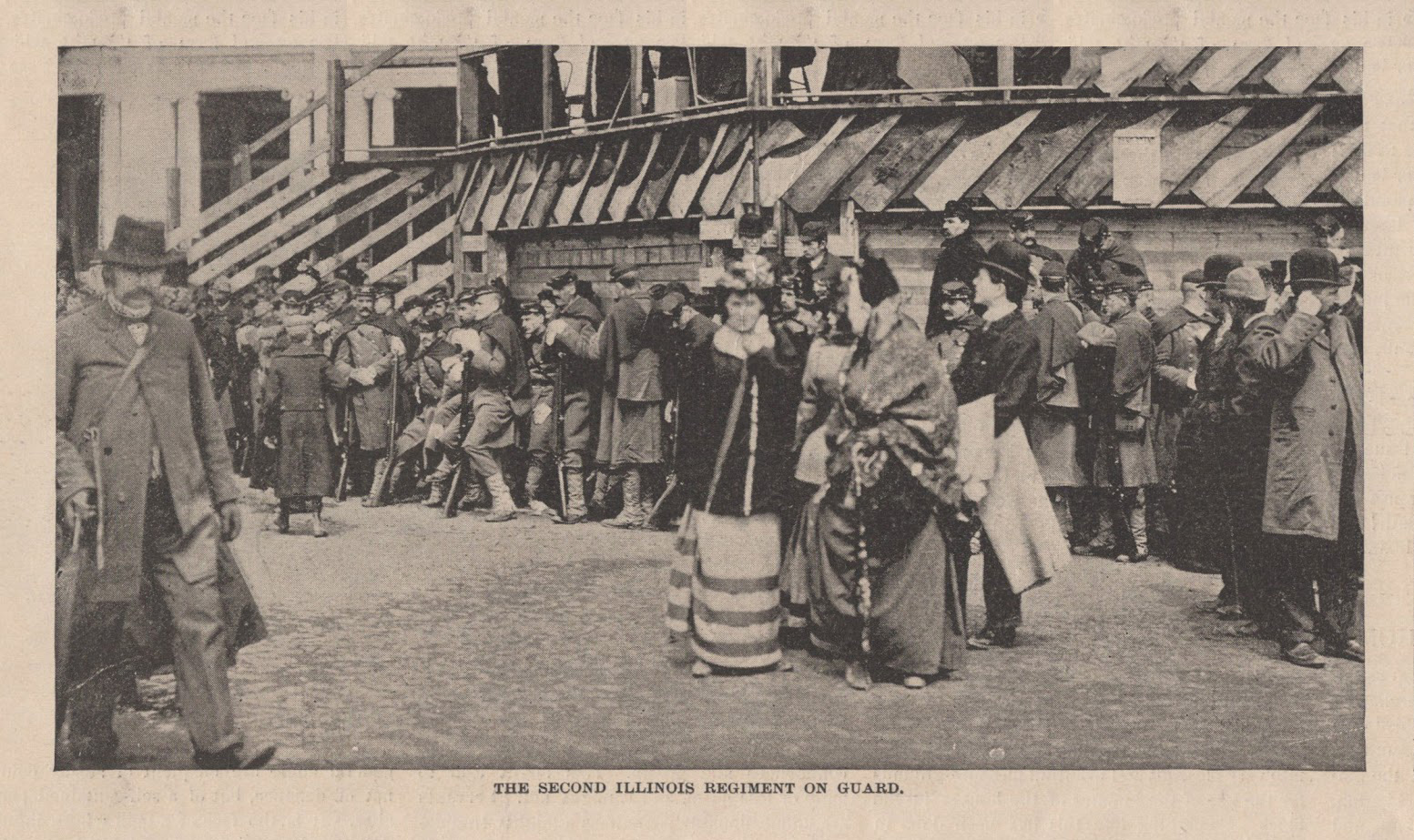
“The Second Illinois Regiment on Guard” over the grandest and noblest gathering ever known. [Image from Frank Leslie’s Illustrated Weekly, May 18, 1893.]
A strange and thorough mixture
More interesting than the notables beginning to assemble on the platform, more interesting than the great white halls, and more interesting than the iron jewelry surrounded the scene, was the display of diverse people. All the races of the world seemed to be blending in the throng. Jostling about among the crowds were Egyptians, Mexicans, Chinese, East Indians, and Japanese, each in their distinctive decorative dress. The red fezzes of the Turks blossomed like poppies.
Viewed from the balcony of the Administration Building, the crowd presented an unusual and a wonderful appearance. With a glass, one could see the faces and costumes from orient to occident, from Greenland’s icy mountains to India’s coral strands, from the plains of the western prairie to the steppes of Asia and the forests of Africa. The Americans, even, were obviously a strange and thorough mixture.
Buffalo Bill and the band of Indians
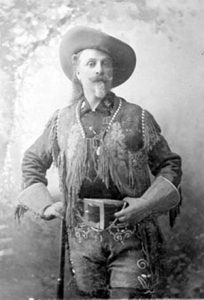
Buffalo Bill Cody (Image from the Buffalo Bill Museum & Grave, Golden, CO.]
Suddenly, from the west, a band of American Indians pressed their way through the crowd, who struck up a cheer to greet them. The colorful headdress of the braves and their red, blue, and yellow wrappings offered a pleasing break in the solid mass of black hats worn by the men, who formed a majority of the crowd.
His wide, white hat identified William F. Cody the moment he turned around the corner of the building. Famous in both hemispheres as “Buffalo Bill,” he was one of the most picturesque figures on the ground, clad in his trademark fur-trimmed coat and immense slouch hat. Everybody seemed to know him, even the dignitaries assembling on stage. The crowd below made a dash in the direction of the new arrivals, soon surrounding them.
Wedging themselves through the throng, Buffalo Bill and the troop of Indians from his “Wild West Show” provided a blaze of rich color in the crowd, providing a brilliant tone echoed in the costume of representatives of other nationalities. The Lakota (then called Sioux) made their way to the opposite corner of the building, needing fully half an hour to get there through the thick crowd.
The key arrives
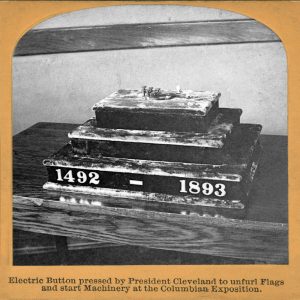
“Electric button” stereoscope card photograph. [Image from the New York Public Library Digital Archive.]
One pale young man nervously adjusted the golden key that would complete the circuit and set all the wheels of machinery whizzing. Satisfied with their work, they covered the table to protect it from rain and left the device to wait for the finger of the president.
All anxious but good-natured
Sporting new blue uniforms decorated with heavy braids and fuzzy pompons on their caps, a regiment of the Columbian Guards formed a line about the speakers’ platform, intent on keeping order. The detachment patrolled up and down in front of the grandstand, keeping the crowd about ten or twelve feet back. A tumultuous sea of humanity began crashing against the line of nervous guards.
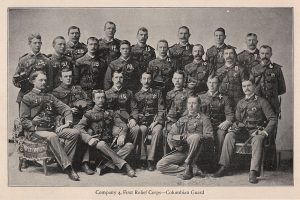
Company 4 of the Columbian Guard [Image from Gibson, J.J. Pictorial Album and History, Worlds Fair and Midway (Harry T. Smith & Co. c1894).]
Ladies and old gentlemen who had no intention of being in such a crowd found themselves practically prisoners, locked in on three sides by solid walls of people pushing and jamming because they were forced by others still behind them.
By the time 50,000 had gathered before the grandstand, the scene resembled a field of clover swaying in the wind. The people moved in ceaseless but subdued motion. Long before the ceremonies opened, it was common to see men fanning fainting women who had become penned up in the center of the crowd and to hear ambulance men loudly called to carry off those who had succumbed to the crush and excitement of the day.
The only open space in the throng was the platform reserved for the fair’s official photographer and his apparatus. Even his domain would have been encroached upon had not the guards fought for his privilege.
As 11 o’clock approached, the crowd bordered on the unruly, being swayed and disturbed by guards who made frequent sallies to either rescue someone in distress or eject someone who had committed an offense.
The Columbian Guard draws their swords
The guards easily might have kept the people away from the grandstand—and were doing so reasonably well—until Director of Works Daniel Burnham allowed the guards to permit people to crowd in from the end. Then the trouble began. The crowd surged up against the little slim barrier that protected the correspondents and would have wiped it out of existence in a second but for a file of soldiers that came along in the nick of time and afforded some protection. Observers safely out of the ruckus feared that any spark could cause a panic and result in a great loss of life.
Once the crowd broke through the lines formed by Columbian guards, they swayed restlessly in front of the grandstand. An army officer, whose broad red stripes on a uniform of blue proclaimed him as an attaché of the artillery, sat in the press section and nervously watched the tide of humanity beat against the untrained guard.
“Draw your swords,” he shouted to a detachment of the guard that struggled against the advancing wall.
A dozen swords flashed in the first sunlight that had broken through the clouds in many a day. The gendarmes waved their side arms threateningly, but the tide could not be stayed. Women were falling in the front ranks, and as guards stooped to raise them to ambulance chairs the lines advanced nearer to the grandstand. The officer of artillery, now thoroughly alarmed, shouted for a messenger, and dispatched him for a troop of cavalry. Presently the troop came rattling over the plaza, pressing its way through the excited mob. A young lieutenant, who rode with the grace of an Indian warrior, came in advance of the troop. His cape, tossed back by the breeze, exposed an orange lining that contrasted strangely with the somber throng about him.
“Into the crowd!” he shouted. The troop plunged across the court and kept back for an instant the advancing wall. Sabers flashed in every direction. The mounted guard stood on the plaza until it became apparent that even they could not head back the enthusiastic throng. Then they rode away and the crowd beat without restraint against the stand.
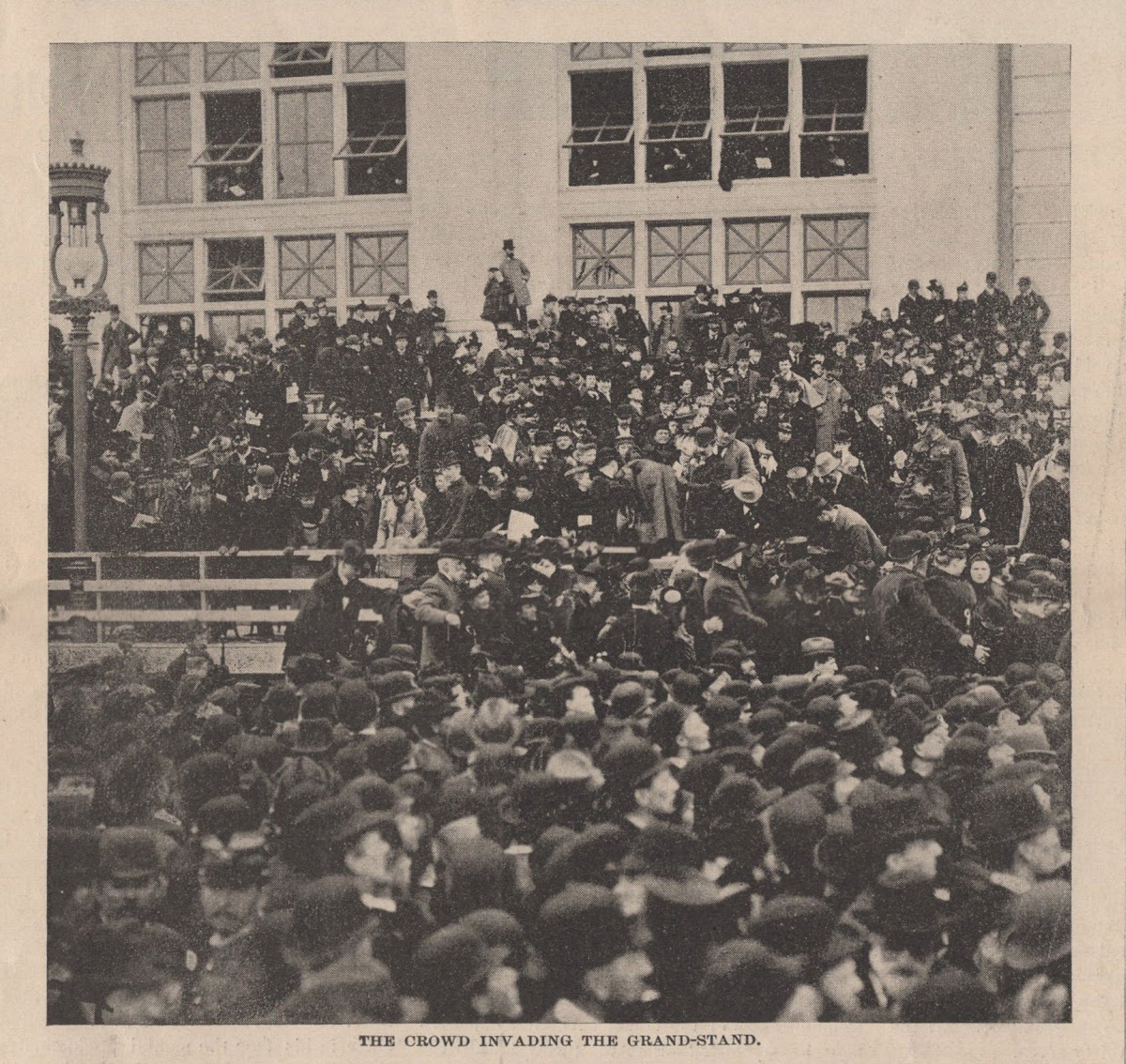
“The Crowd Invading the Grand-Stand” from Frank Leslie’s Illustrated Weekly, May 18, 1893.
Indians watch from above
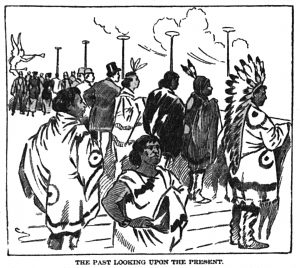
“The Past Looking Upon the Present” from the Chicago Inter Ocean, May 2, 1893.
Looking down upon the scene from high up on the topmost balcony of the Administration Building was a band of American Indians who had come over from their settlement on the Midway to witness the opening ceremonies. Seventy-five strong and resplendently dressed, they stretched in a line the whole length of the eastern balcony directly above the great platform where the exercises would soon begin.
Below, workers finish decorating the platform by placing Turkish rugs underneath the presidential seats and arranging the last of the potted plants. The arrival of sunlight prompts them men to remove the protective waterproof layer from the table bearing the golden key.
Invited guests stream in
As sunshine burst through the clouds, hundreds of invited guests began streaming through the narrow, scarlet stairway and took their places on the grandstand.
The amphitheater stretched across the entire east front of Administration Building. The larger main platform had a seating capacity for nearly 2,000 persons. In front of that was a smaller platform for President Cleveland and his cabinet, the Duke of Veragua and his suite, foreign commissioners and other guests of honor, numbering about sixty in all.
A few minutes before 11 o’clock the chiefs of the various departments of the Exposition and members of the Board of Lady Managers arrived and were ushered to their seats. Directors of the Fair, many of them accompanied by their families, took chairs to the right and in the rear of the rostrum kept for the presidential party and the guests of the nation. Behind them in the distance, were seats for members of Director General Davis’ cabinet, the men who have collected all the exhibits for the Fair. Further to the left were grouped state World’s Fair boards and the leading spirits of the World’s Congress Auxiliary.
On the opposite side, a section was reserved for state governors, senators, and congressional representatives. Still further to the left, members of the national commission strolled in. Over farther, toward the statue of Benjamin Franklin that stands proudly at the entrance of Electricity Hall, were Chicago aldermen, members of the Board of Education, city park commissioners, Cook County commissioners, and members of the Illinois legislature.
Other distinguished guests included judges of the Supreme Court and members of the Diplomatic Corps.
In the far back section among the congressional delegates, Frederick Douglass shook hands and bowed to the large number of people who knew him before working his way down to the front section reserved for diplomats. Douglass had served as U.S. Minister to Haiti.
They burst upon the scene in the gorgeous regalia
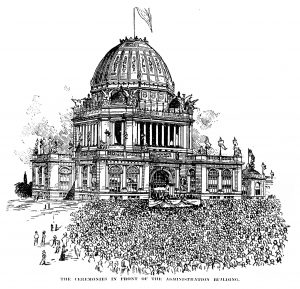
“The Ceremonies in Front of the Administration Building” from the Chicago Eagle, May 6, 1893.
All of a sudden, a roar came from the Administration Building and seemed to make the great dome tremble. The crowd cheered wildly as the foreign dignitaries burst upon the scene. Wearing the gorgeous regalia of European and Asiatic courts, this brilliant dash of color enlivened the otherwise dark picture. Spectators could spot representatives based on their attire as coming from England, Germany, Russia, Japan, Spain, Italy, or France.
The national costume of the Korean delegation created a sensation among the crowd. The “fantastic attire”—such as had never before been seen in Chicago—featured dresses of heavy silk with yellow sleeves, small white streamers around the neck, and brilliant red and black hats.
To the right and left of the President’s stand were seats for about 250 members of the press, each writing accounts to send back to their hometown periodicals. Among them was a diminutive Japanese gentleman smartly dressed in a white vest, white gloves, and white necktie–a staff correspondent for the Tea Review of Japan.
The great sounding board
Under the main arch of the building and having for its base the topmost row of seats on the grandstand, was a great sounding board where the six-hundred musicians of the Exposition Orchestra sat. After conductor Theodore Thomas assembled his performers into position, the cacophony of instruments tuning announced the imminent arrival of the president.
Invited guests on the platform—some climbing on their seats—turned nervously toward the narrow stairway, and listened eagerly for the shout announcing the arrival of the presidential party.
A great billow passed through the sea of humanity
Shortly after 11 o’clock, a great cheer heralded the arrival of the principle actors. Down the aisle came President Cleveland escorted by Director-General Davis. Then came Vice President Stevenson, members of the President’s family, and ladies of the cabinet circle. Rev. William H. Milburn, the “blind chaplain” of the Senate, followed. Secretaries Gresham, Carlisle, Smith, Herbert, and Morton of the president’s cabinet took their places. Close behind were President Harlow Higinbotham of the World’s Columbian Exposition and President Thomas W. Palmer of the national commission.
While kerchiefs were waving and hats were soaring, Director General Davis tramped proudly on the platform with the president at his right. Upon the arrival of Mr. Cleveland at the speaker’s stand, a great billow passed through the sea of humanity as the mighty assembly broke into deafening cheers. The roar of applause checked President Cleveland at the very threshold of the grandstand. He paused for an instant as his eye swept the scene, standing with bared head before the multitude.
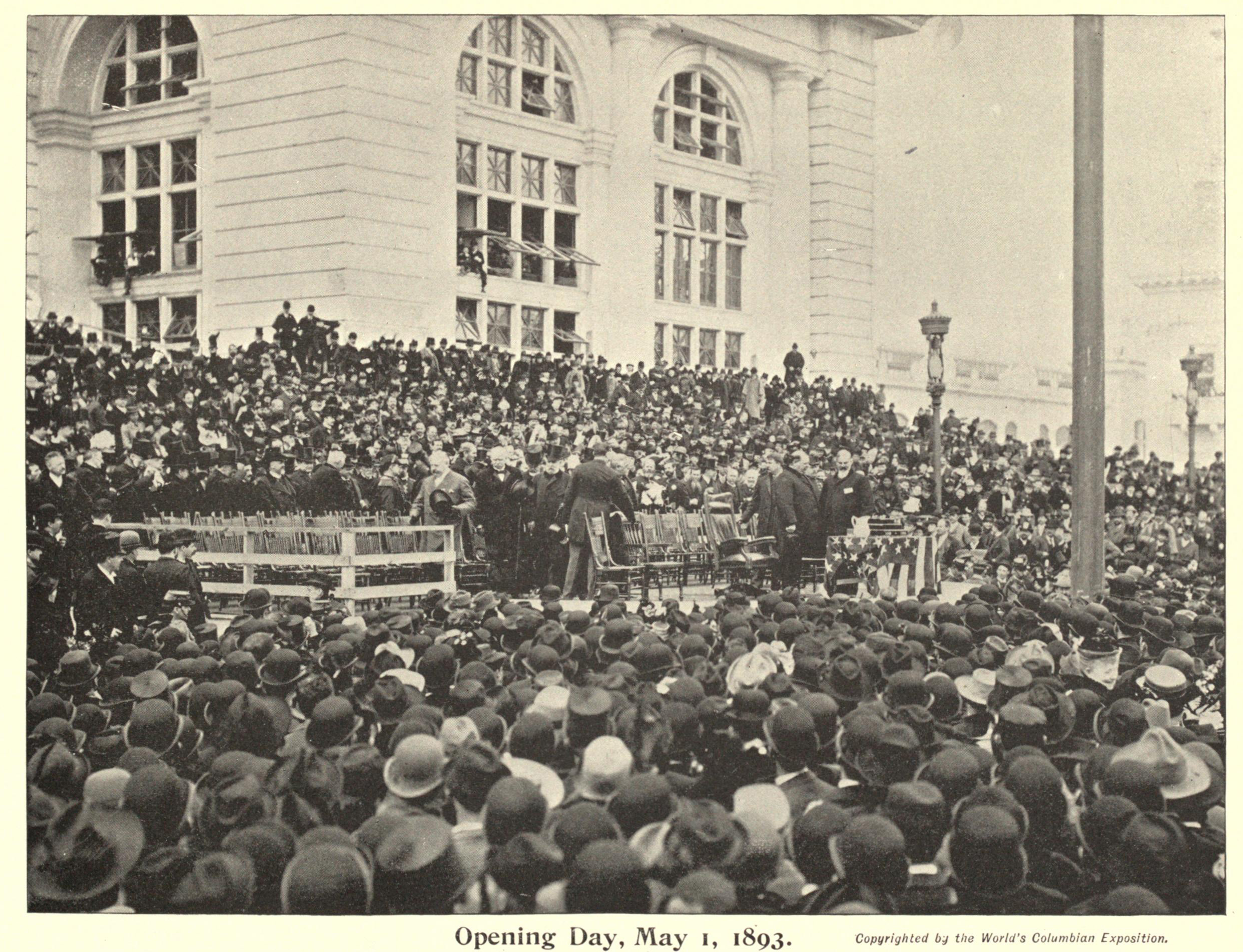
The grandstand filled with dignitaries on Opening Day. [Image from Shepp’s World’s Fair Photographed (Globe Bible Publishing, 1893).]
The president’s chair
Director-General Davis led President Cleveland to the pedestal on which rested the golden telegraph key. Colonel Davis pointed to the instrument and spoke a few words of instruction. The president nodded in assent, understanding what he had to do to start the machinery.
At the front of the stage, an immense leather-seated and oak-framed chair awaited Mr. Cleveland, who walked boldly down to the swinging seat reserved for him and sat in it with confidence. The chair tilted too far back with its momentous freight, however, so was quickly discarded and a seat more modest and secure put in its place.
The Spanish party enters the scene
Just as the President took his seat, the Spanish party entered the scene. Cheering recommenced throughout the grand court.
The Duke of Veragua entered, escorted by Director Charles Henrotin. With him walked the Duchess of Veragua, escorted by Mrs. Potter Palmer, followed by the other members of the ducal party. Mrs. Palmer and the descendants of Columbus occupied prominent seats at the front of the platform.
Director of Works Burnham, Lyman J. Gage, Ferd W. Peck, James W. Ellsworth, and other Directors of the Fair found their positions.
Toward the end of the procession, Mayor Carter Harrison elbowed his way down the platform. The crowd sent up wild whoops to acknowledge him.
Terrible pressure of the human sea
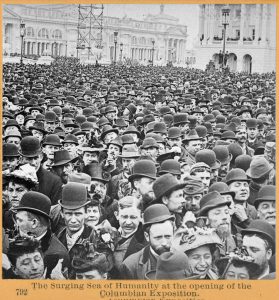
“The Surging Sea of Humanity” stereoscope card photograph.
As the ceremony unfolded that morning, the sea of humanity continued to swell. With mighty surges, the jelly mass reeled this way and then that. Now and then the surf beat up to the breakwater provided by the timbers of the platform. Disregarding the line of guards as if they were straws set in the sand, the human waves cast men, women, and children against the wall.
Conservative estimates placed the number immediately in front of the speaker’s stand and the roadways leading east on either side of the basin at 150,000. There were thousands more on the ground who, as far as seeing the ceremonies were concerned, might as well have remained at home … but still they came.
Men climbed up the electric light poles and hung thirty feet above the moving mass of heads below them. Against the edge of MacMonnies Fountain some were pressed so hard that their hand trembled over the water. The Duke of Veragua leaned forward in his chair, astonished by the scene below.
Women fainted by the score. In a dozen places at once, one could see them with their heads lopped over, like the top of a tulip that had been broken by the force of the storm. Men, too, fainted under the terrible pressure of the human sea.
Some guests were squeezed until their ribs fairly cracked. At least twenty women succumbed to the pain and torture of the crush. A man jumped onto one of the press tables and yelled at the mob: “For God’s sake stand back. You are killing these women in front.” One elderly lady caught up in the crowd held on to the barricade as long as she could, but finally fainted. She was dragged over the rail and laid out on one of the reporter’s tables.
The orchestra began to play a lively march.
Throughout this storm, the band of Lakota Indians lined up along the portico of the Administration Building stood together like rocks, without stirring a hair’s-breath from their proud, erect positions.
SOURCES
(See our note about sources here.)
“Choked by Traffic” Chicago Daily Tribune May 2, 1893, p. 5.
“Cleveland Presses the Golden Key” Salt Lake Herald May 2, 1893., p. 1.
Dedicatory and Opening Ceremonies of the World’s Columbian Exposition. Stone, Kastler & Painter, 1893, p. 259.
“Epoch in History” Chicago Herald May 2, 1893, p. 1.
“‘Gath’ of the Fair” Chicago Daily Tribune May 2, 1893, p. 9.
“How it was Opened” Chicago Inter Ocean May 2, 1893, p. 1.
“Hundreds of Thousands There” Chicago Herald May 2, 1893, p. 2.
“In the Grand Stand” Chicago Daily Tribune May 2, 1893, p. 1.
“Michigan Avenue a Popular Route” Chicago Herald May 2, 1893, p. 2.
“Opened to the World” Chicago Eagle May 5, 1893, p. 6.
“Opening Ceremonies World’s Columbian Exposition” in Columbian Exposition Dedication Ceremonies Memorial. Metropolitan Art Engraving & Publishing Company, 1893, pp. 212-224.
Pickett, Montgomery Breckinridge “Opening of the Great Fair” Harper’s Weekly May 13, 1893, p. 442.
“Were There to See” Chicago Inter Ocean May 2, 1893, p. 2.
“Viewed from Above” Chicago Daily Tribune May 2, 1893, p. 5.
“‘White City’ Half in Cloud Land” Chicago Daily Tribune May 2, 1893, p. 1.
“Women Hurt in the Awful Crush” Chicago Daily Tribune May 2, 1893, p. 1.

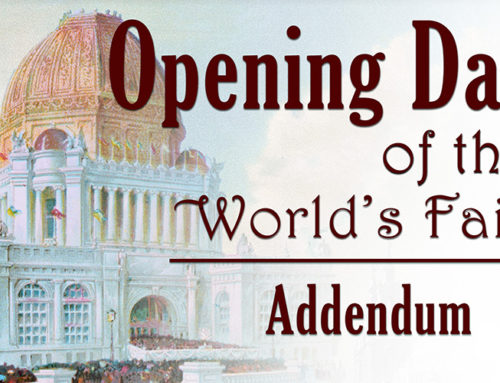
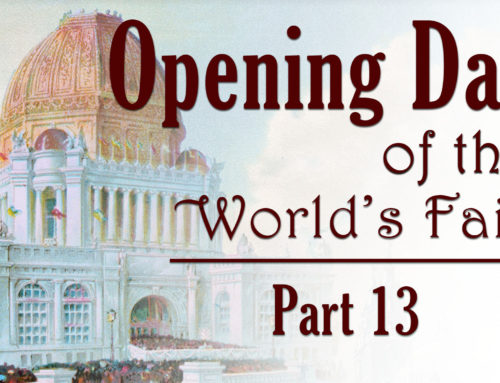
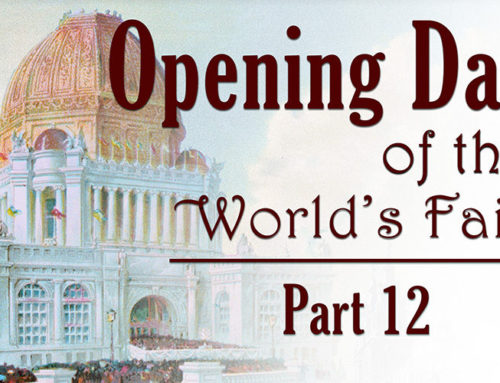
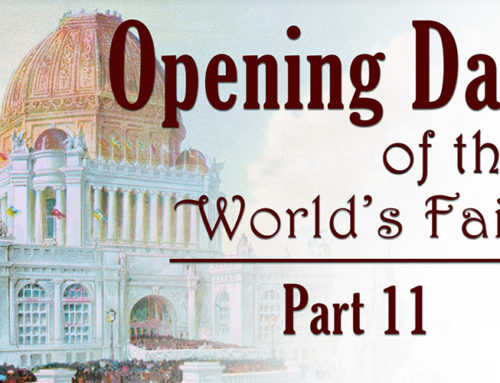
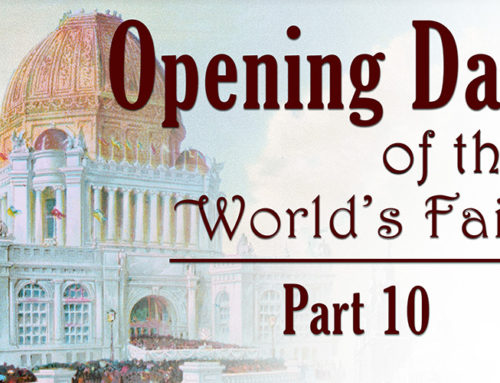
Leave A Comment